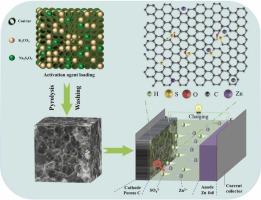Double alkali metal salts synergistic activation coupled with S-doped cotton derived honeycomb porous carbon for enhanced zinc ion storage capability
IF 5.8
2区 材料科学
Q2 CHEMISTRY, PHYSICAL
引用次数: 0
Abstract
Biomass-derived carbon materials are ideal electrode materials due to their inherent eco-friendliness, easily available and unique micro-morphology. Herein, zinc ion capacitors (ZICs) are designed utilizing S doped honeycomb porous carbon nanosheet cathode, which is obtained via synergistic activation from sodium thiosulfate and potassium carbonate. The honeycomb microstructure is result from the pore-forming effect of double alkali metal salts, which can promote the electrolyte ion fast migration in the cathode. Besides, the S doping in carbon array can regulate the electron distribution within the carbon framework and lower the energy barrier for the chemical absorption of Zn2+/H+, which is demonstrated by density functional theory calculation and expected to produce additional capacitance. Further, the ex-situ X-ray photoelectron spectroscopy reveals the consistent changes in C-O-H and C-O-Zn throughout the charging and discharging cycles, which demonstrate the S doping can promote the reversible chemical adsorption and desorption reaction of Zn2+/H+. As a result, the S doping honeycomb porous carbon nanosheet cathode can achieves a high discharge capacity of 147.2 mAh g-1 and high energy density of 92.7 Wh kg-1. Additionally, the obtained material exhibits good cycling stability at 20 A g-1, retaining 99.9% of its initial capacity after 2000 cycles. This research presents a versatile approach to synthesizing heteroatom-doped carbon materials from biomass waste for ZICs.

双碱金属盐协同活化与掺杂 S 的棉衍生蜂窝状多孔碳相结合,增强锌离子存储能力
生物质衍生碳材料因其固有的生态友好性、易获得性和独特的微形态而成为理想的电极材料。本文利用掺杂 S 的蜂窝状多孔碳纳米片阴极设计了锌离子电容器(ZIC),这种阴极是通过硫代硫酸钠和碳酸钾的协同活化作用获得的。双碱金属盐的孔隙形成效应产生了蜂窝状微观结构,从而促进了电解质离子在阴极中的快速迁移。此外,碳阵列中的 S 掺杂可以调节碳框架内的电子分布,降低 Zn2+/H+ 化学吸收的能量势垒,这一点已在密度泛函理论计算中得到证实,并有望产生额外的电容。此外,原位 X 射线光电子能谱显示,在整个充放电循环过程中,C-O-H 和 C-O-Zn 的变化是一致的,这表明 S 掺杂能促进 Zn2+/H+ 的可逆化学吸附和解吸反应。因此,掺杂 S 的蜂窝状多孔碳纳米片阴极可实现 147.2 mAh g-1 的高放电容量和 92.7 Wh kg-1 的高能量密度。此外,所获得的材料在 20 A g-1 的条件下表现出良好的循环稳定性,在 2000 次循环后仍能保持 99.9% 的初始容量。这项研究提出了一种从生物质废料中合成掺杂杂原子的 ZIC 碳材料的多功能方法。
本文章由计算机程序翻译,如有差异,请以英文原文为准。
求助全文
约1分钟内获得全文
求助全文
来源期刊

Journal of Alloys and Compounds
工程技术-材料科学:综合
CiteScore
11.10
自引率
14.50%
发文量
5146
审稿时长
67 days
期刊介绍:
The Journal of Alloys and Compounds is intended to serve as an international medium for the publication of work on solid materials comprising compounds as well as alloys. Its great strength lies in the diversity of discipline which it encompasses, drawing together results from materials science, solid-state chemistry and physics.
 求助内容:
求助内容: 应助结果提醒方式:
应助结果提醒方式:


